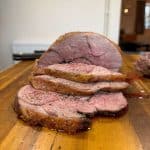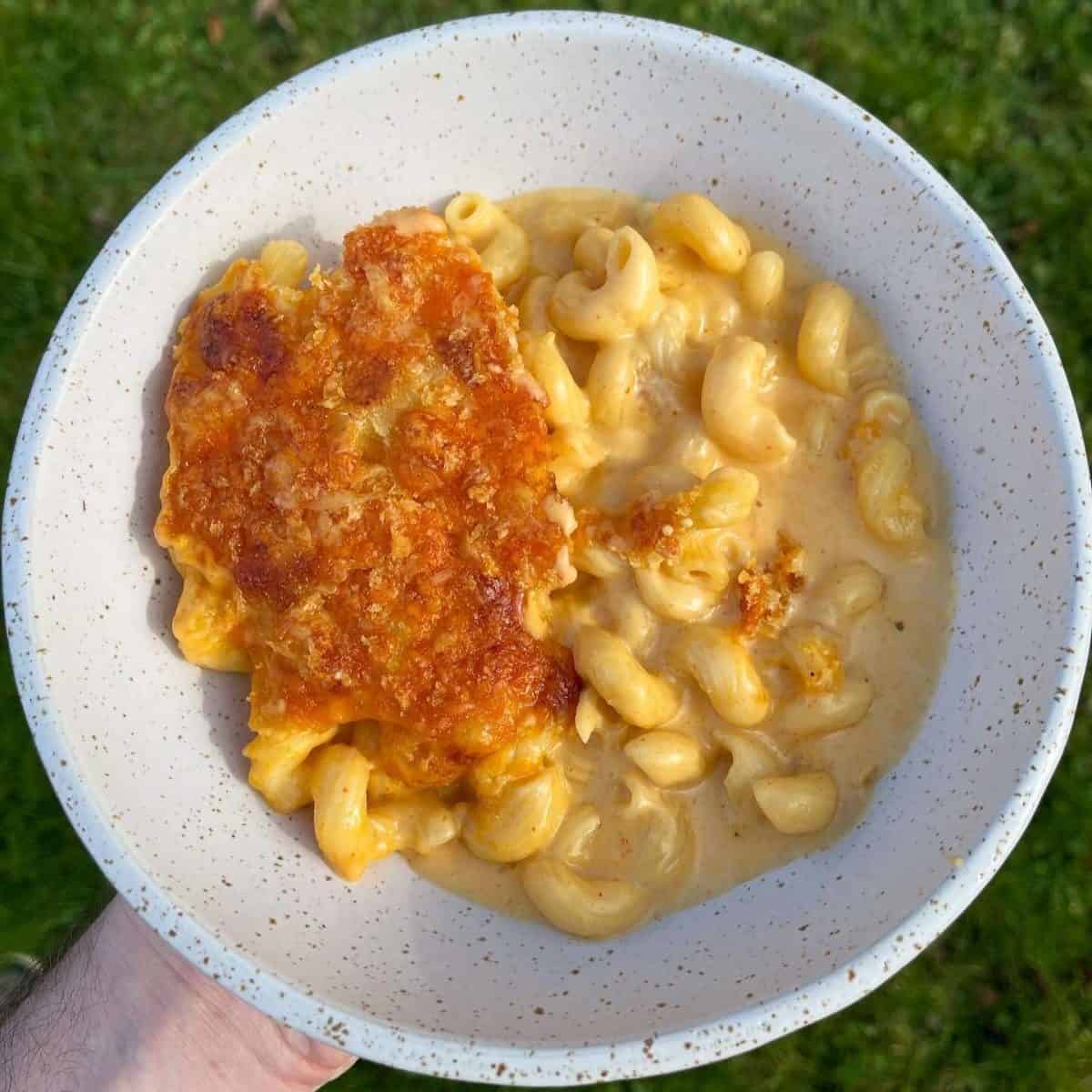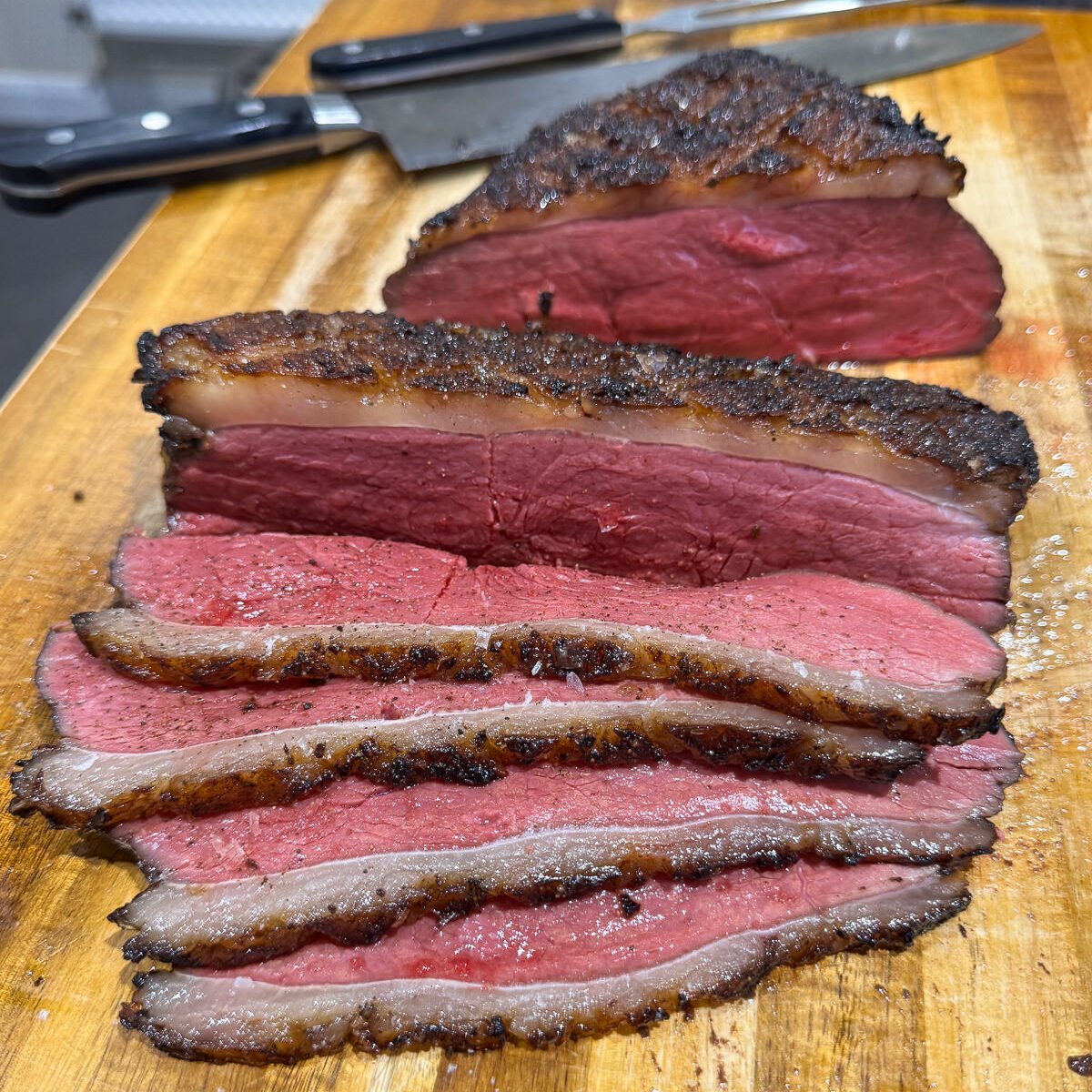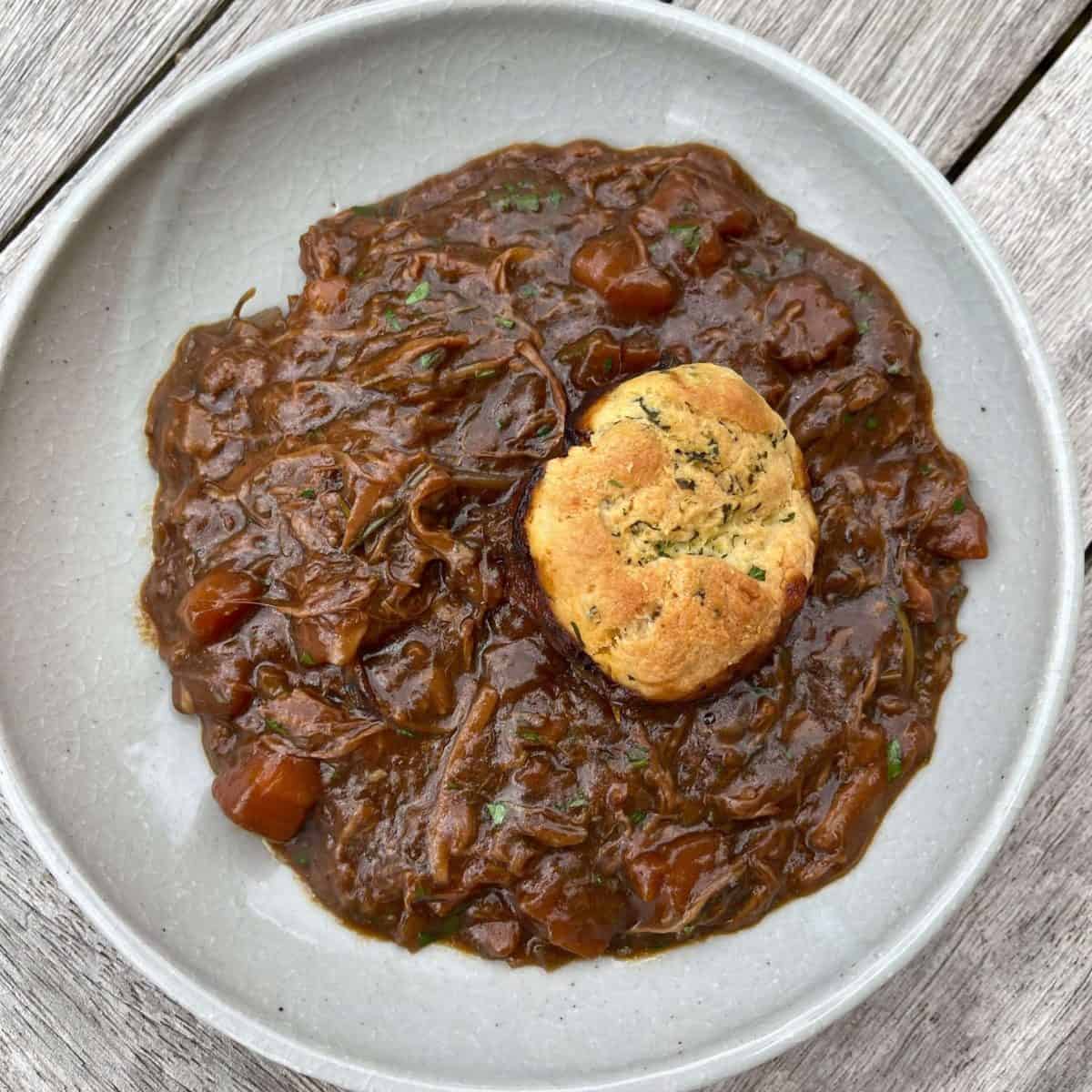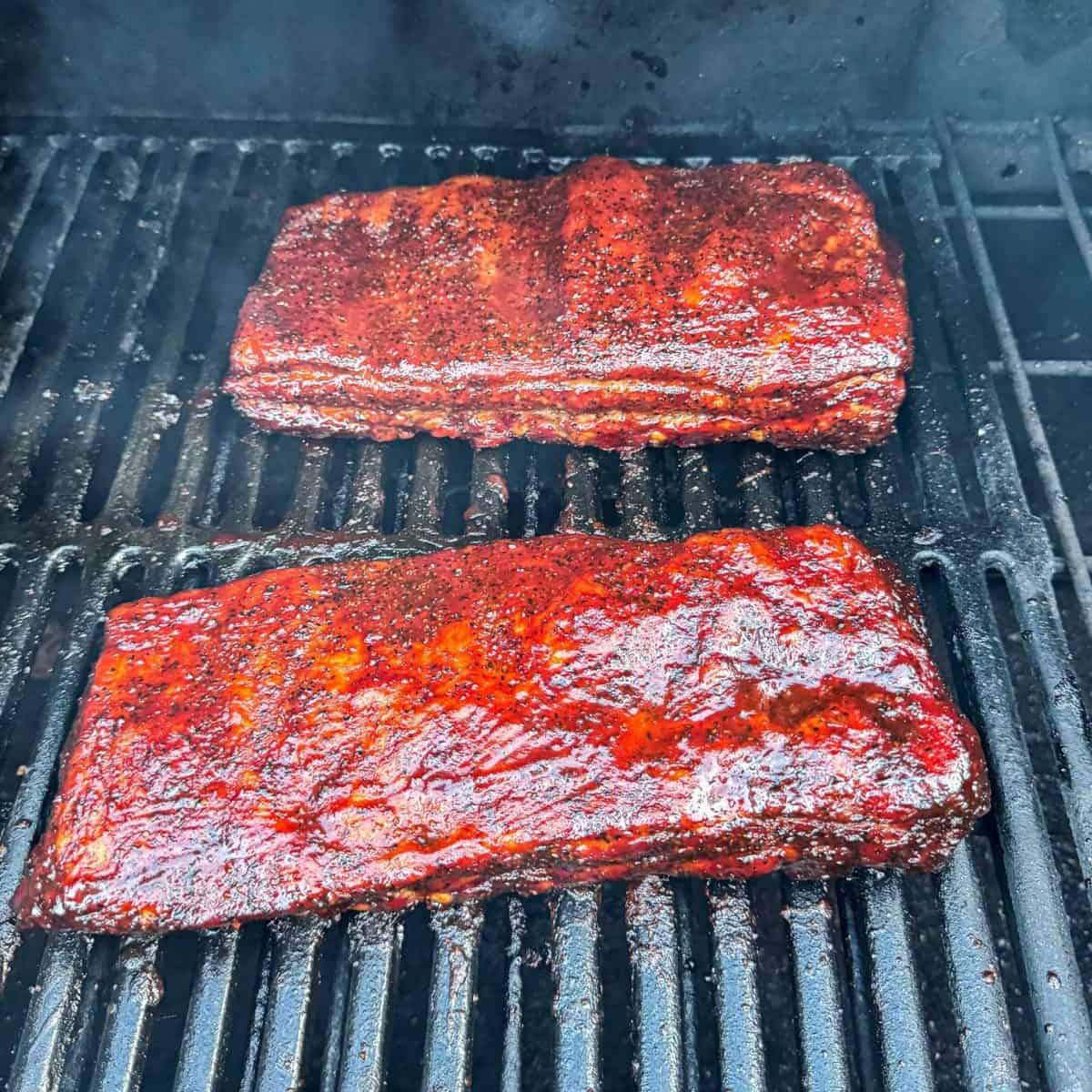Slow Roasted Leg Of Lamb (Reverse Seared)
Here’s how to cook a slow roasted leg of lamb that’s perfectly pink, tender & full of flavour. We’ve removed part of the leg bone as well, to make our roast lamb easier to carve!
This post contains affiliate links.
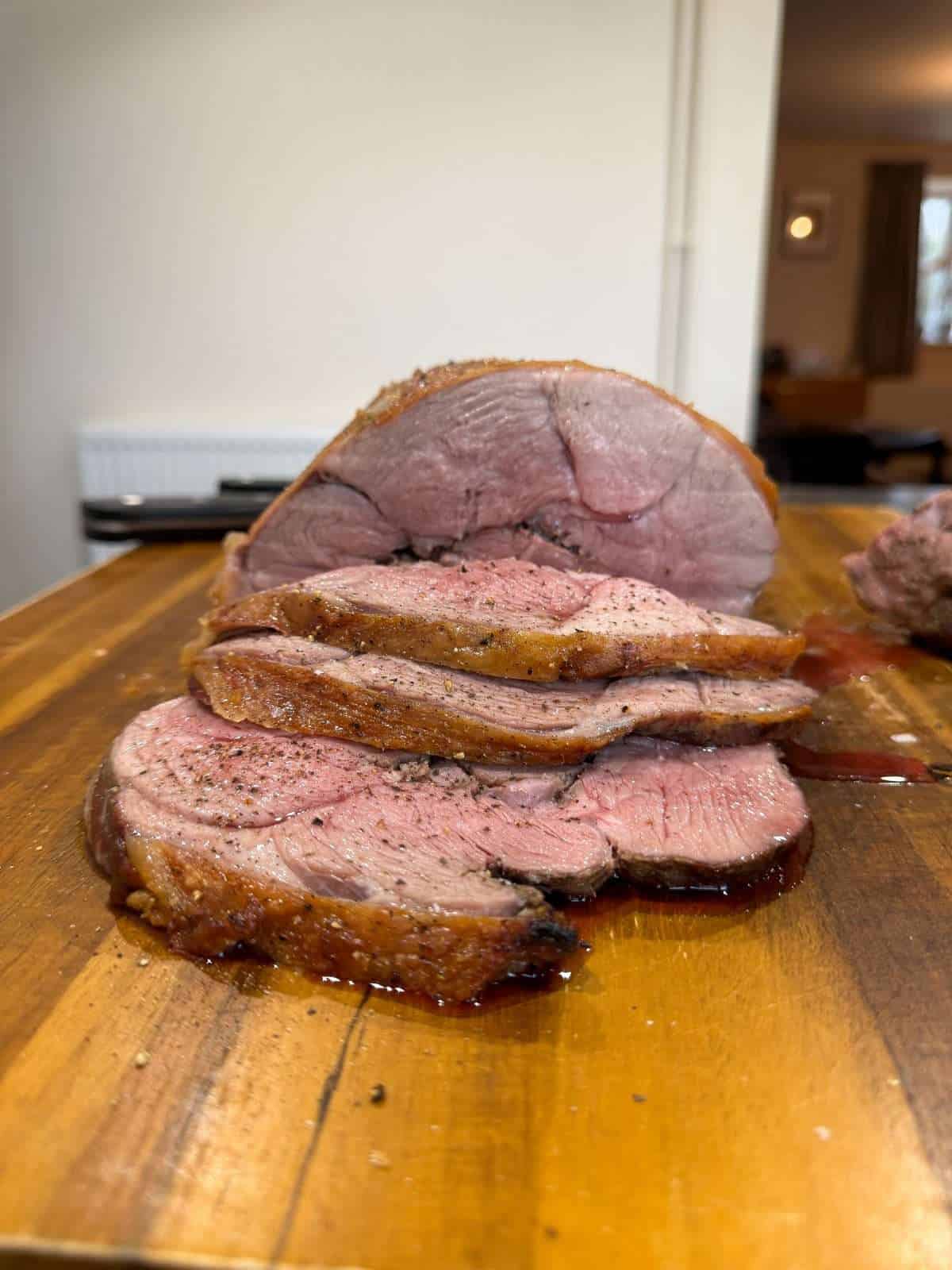
Roast lamb is easily my favourite choice of meat for a roast dinner & it doesn’t get better than our slow roasted, reverse seared leg of lamb!
To make this roasted leg of lamb, we’re going to be removing the leg bone (and any connective tissue, cartilage and sinew), marinating the meat with rosemary & garlic, roasting it gently for several hours until perfectly pink then searing at a high temperature to crisp up the skin. This lamb’s tender, packed full of flavour & super easy to carve. It’s perfect for roast dinners & any leftovers can be used for salads, sandwiches, pies, pasta & loads more…
Lamb tends to be quite expensive & there’s a bit of prep to do here, so I reserve this recipe for special occasions. It’s definitely worth it though, this is some next level roast lamb!
Some exciting news! I’ve just released my roast dinner eBook over on my brand new online store! This contains everything you need to make a restaurant style roast dinner, including perfectly roasted meats, plenty of side dishes & sauces to serve with different meats.
What Is Reverse Searing?
Reverse searing has gained popularity over the last few of years & for good reason! This method of cooking involves slowly cooking meat at a low temperature, to your desired doneness then searing to finish (either in a super hot oven or in a pan). If you want to make a perfectly pink, tender roasted leg of lamb, this is one of the best ways to do it!
When you slow roast a leg of lamb for reverse searing, you’ll need to set your oven to a slightly higher temperature as appose to when you cook roast beef (only a 20 degrees or so), as leg of lamb has more connective tissue & fat that needs to be cooked down & rendered. I slow roast leg of lamb at 120°c/248°f for 2-3 hours then sear it at my oven’s highest temperature.
What You’ll Need
- Leg Of Lamb – For this recipe, you’ll need a whole leg of lamb with the bone left in. This will weigh around 2kg. If you’d prefer, you could ask your butcher to take the bone out of the leg for you or you can leave it in.
- Garlic & Rosemary Marinade – This is a quick & simple marinade that works perfectly with lamb. To make this we mix finely chopped rosemary with grated garlic, lemon zest, olive oil, sea salt & freshly cracked black pepper.
- Digital Food Probe – A probe is a crucial bit of kit when it comes to roasting meat as it lets us check the internal temperature of the meat. I use a Thermapen!
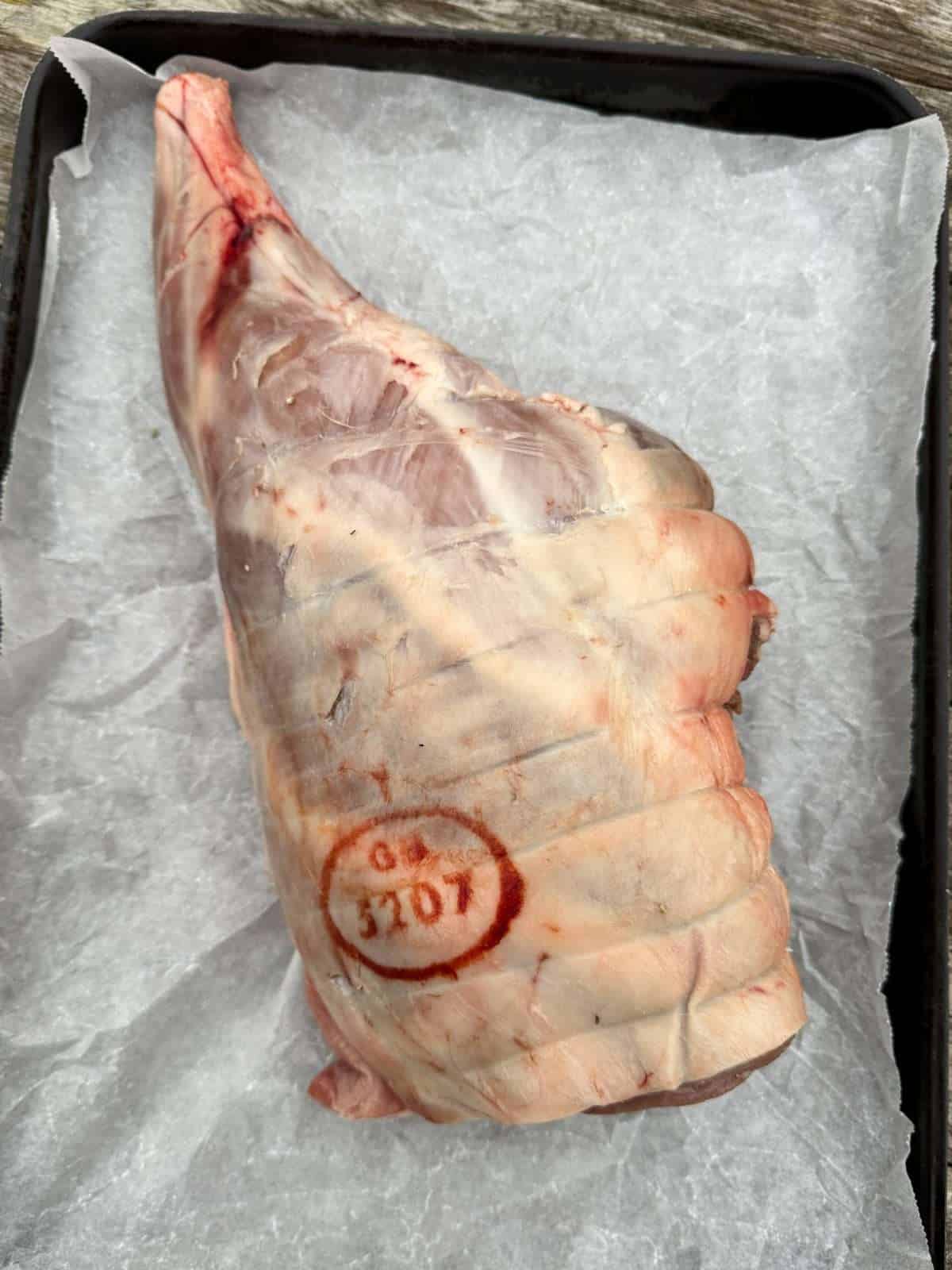
How To Debone A Leg Of Lamb For Easy Carving
Although leaving the bone in a leg of lamb adds flavour, it does get in the way of carving! To get around this, we’re going to debone the lower section of our leg of lamb but leave the bone in at the top, for presentation & flavour. Taking the bone out of the leg, also lets us marinade the meat & gives us a chance to remove any connective tissue, cartilage & excess fat from inside the leg which can make the meat tough. Here’s how we do it…
There’s a video showing how to do this process further down this post! The removed leg bone can be used for stock or gravy.
- Start by patting the meat dry with kitchen paper. This makes it easier to handle!
- Next, set the leg of lamb onto a large cutting board so that it’s facing skin/fat side down & the shank is facing away from you. Use your fingers to feel where the bone is running through the bottom part of the leg.
- Using a sharp boning knife, cut straight through the meat in the bottom part of the leg until you reach the bone. Make sure not to cut into the shank though, as we’re leaving the top part of the bone in the leg.
- Use the tip of your knife to carefully cut the meat away from the top & sides of the bone, cutting away small sections at a time. Work your way up the bone towards the knee joint & shank (but don’t cut past the joint).
- Once you’ve cut enough meat away from around the bone, you’ll be able to get the tip of your knife underneath, to cut the meat away from the bottom part of the bone as well. Keep working your way up & around the bone until you reach the top of the bone, where it connects at the knee joint.
At this point, the bone will be free from the leg meat but still attached at the joint. - Bend the leg bone up towards the shank, to open up the joint then cut between the 2 bones (through the joint) & around the top of the leg bone, to release it.
- Trim any bits of bone, cartilage or big chunks of fat from inside the leg then butterfly the meat on either side of where the bone was, making sure not to cut all the way through the meat.
- Lightly score the meat inside the leg in a criss cross pattern then spoon over the marinade & massage into the meat.
- Fold the meat back together, to its’ original position then flip the leg over so that it’s facing skin side up. Tie the boneless portion of the leg up with butcher’s twine, to secure, leaving a couple of centimetres between each piece.
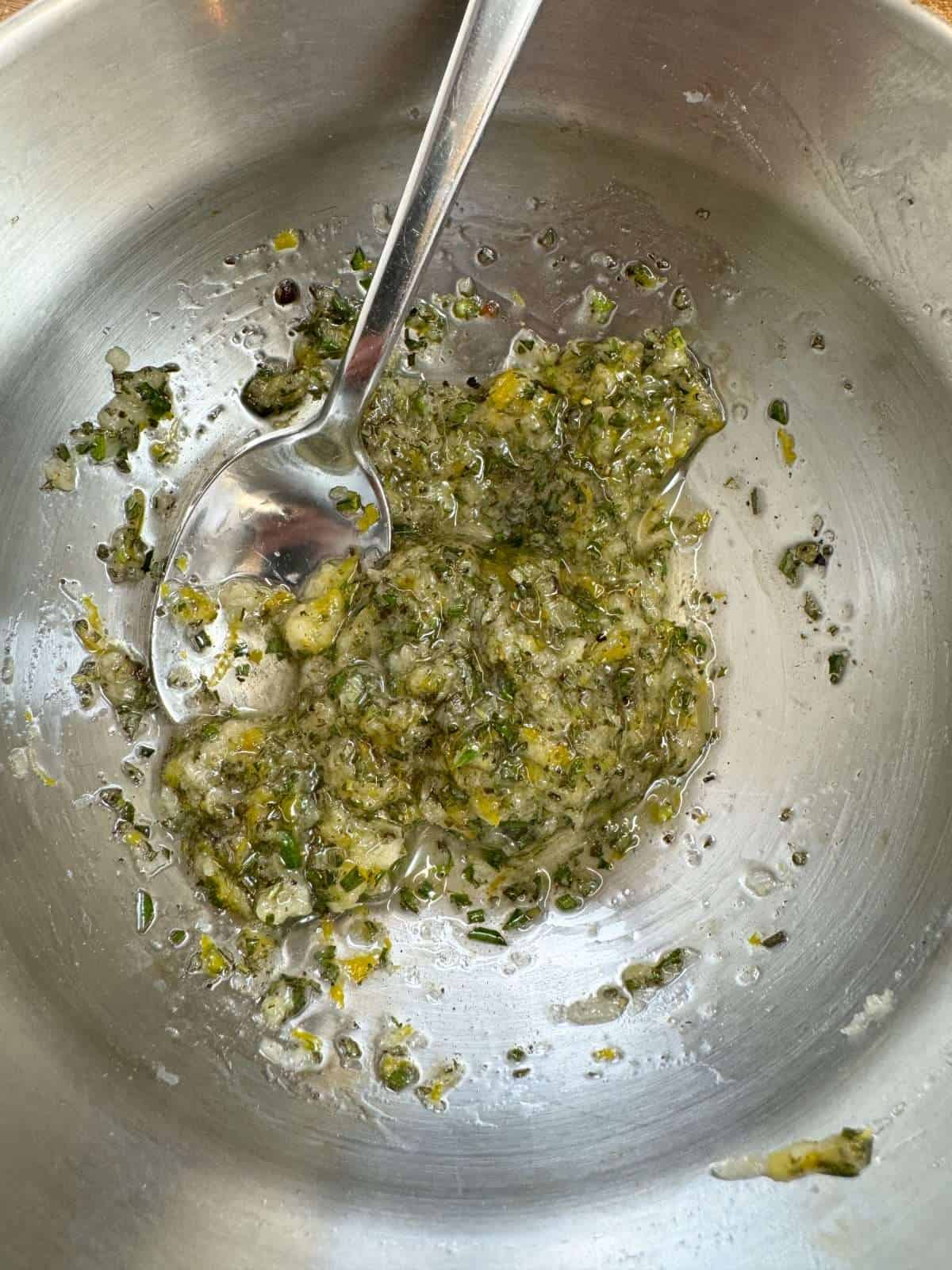
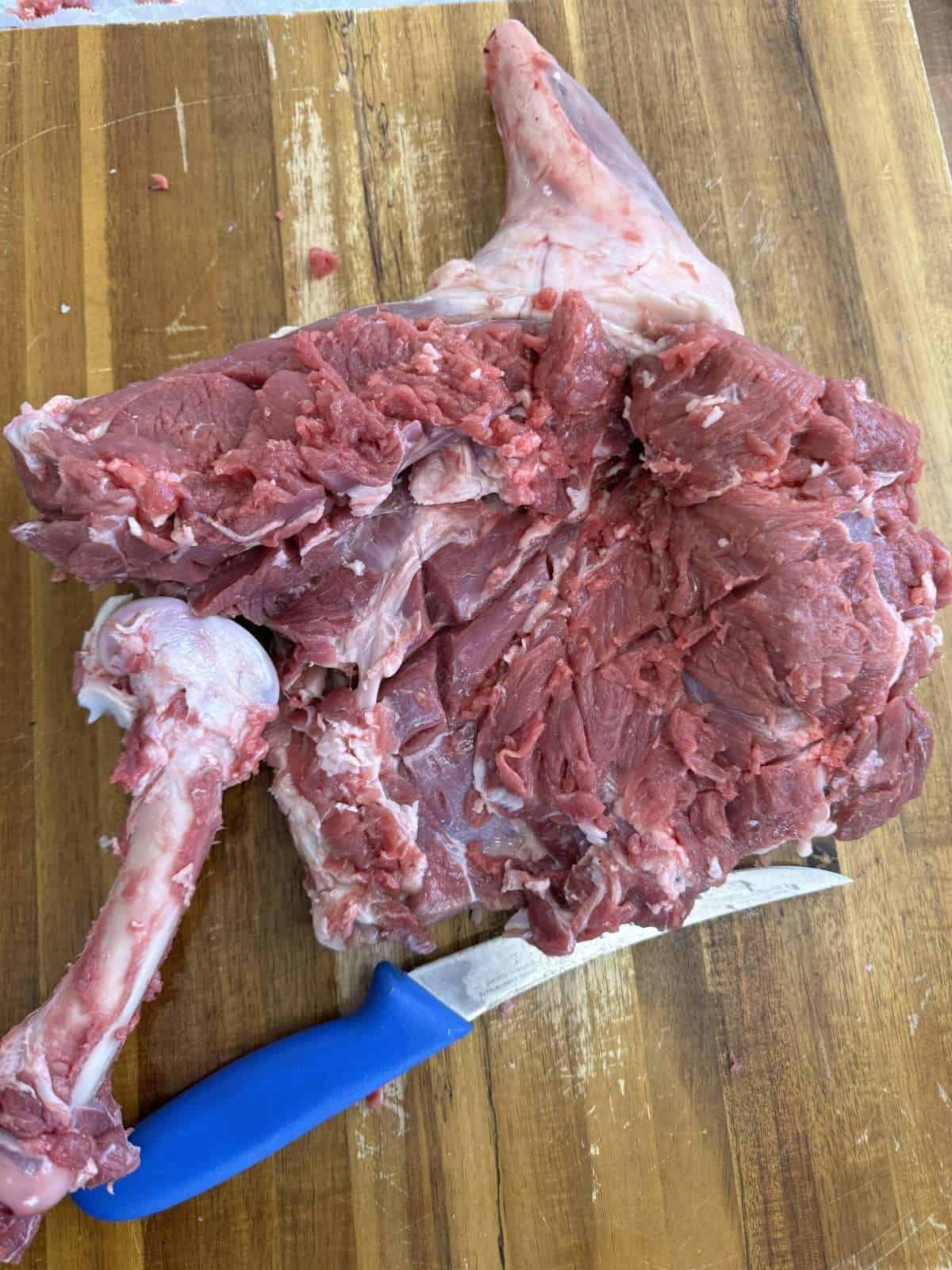
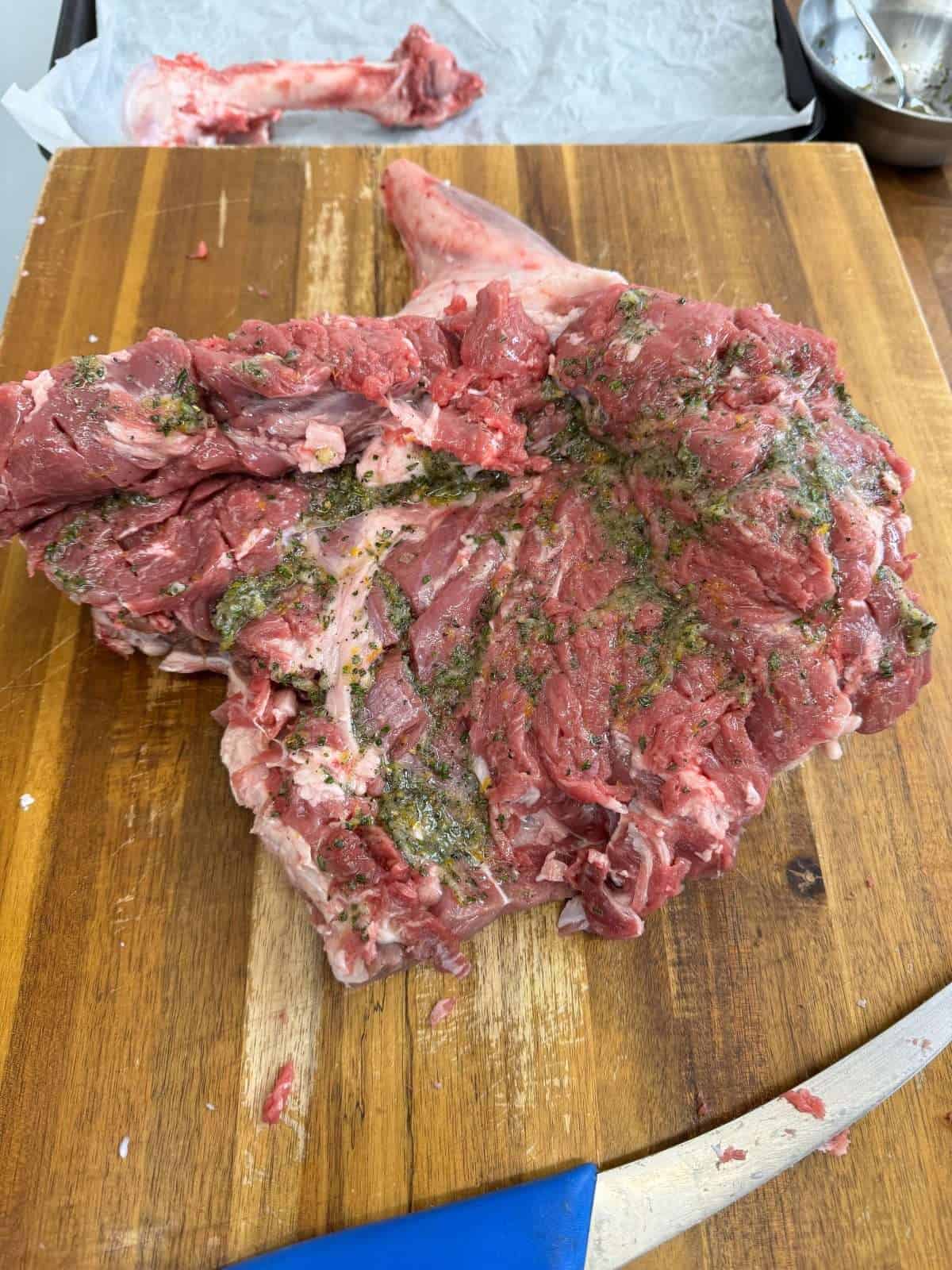
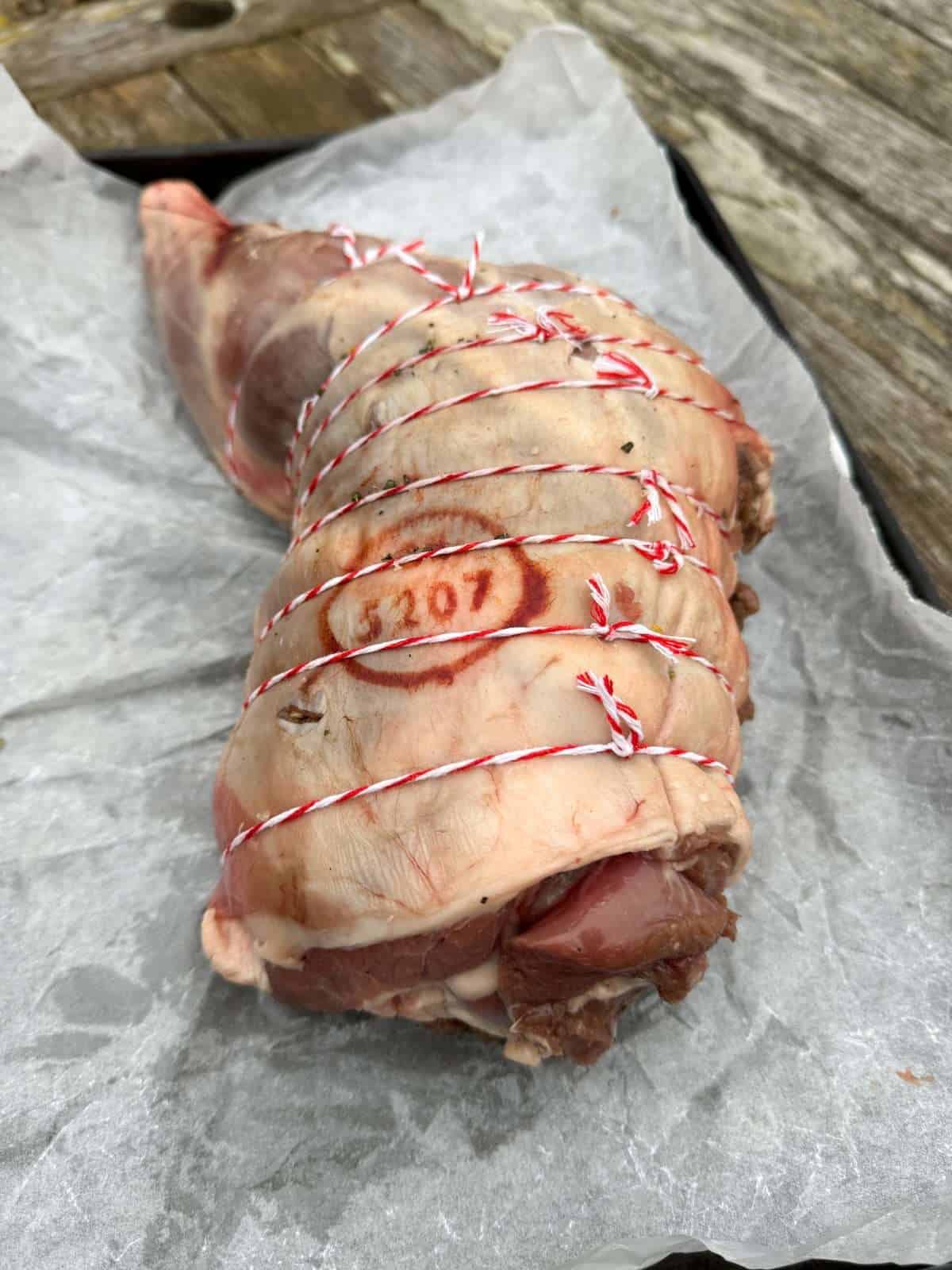
How To Make Reverse Seared Roast Lamb
When it comes to reverse searing, most people tend to think of beef but it works really well with lamb as well! With this method, we slowly roast the lamb at a low oven temperature to bring it up to our desired internal temperature (I like to cook lamb medium!), then give it a good rest before searing the meat in an oven set to its’ highest temperature.
The meat’s perfectly pink, tender & juicy and the lamb skin is golden and crisp! Here’s how we do it…
Slow Roasting
- Take your leg of lamb out of the fridge, place onto a wire rack set inside a roasting tin then let sit at room temperature for 1 hour.
- In the meantime, preheat your oven to 120°c/248°f. If your oven won’t got this low, set it to its’ lowest setting.
- Coat the outside of the lamb with a light layer of olive oil then season well with sea salt & freshly cracked black pepper.
- Cook your joint of lamb in the preheated oven until the internal temperature in the centre of the meat reaches 55°c/131°f. This will roughly take between 2-3 hours.
If you prefer your lamb cooked more, feel free to keep cooking it past this temperature!
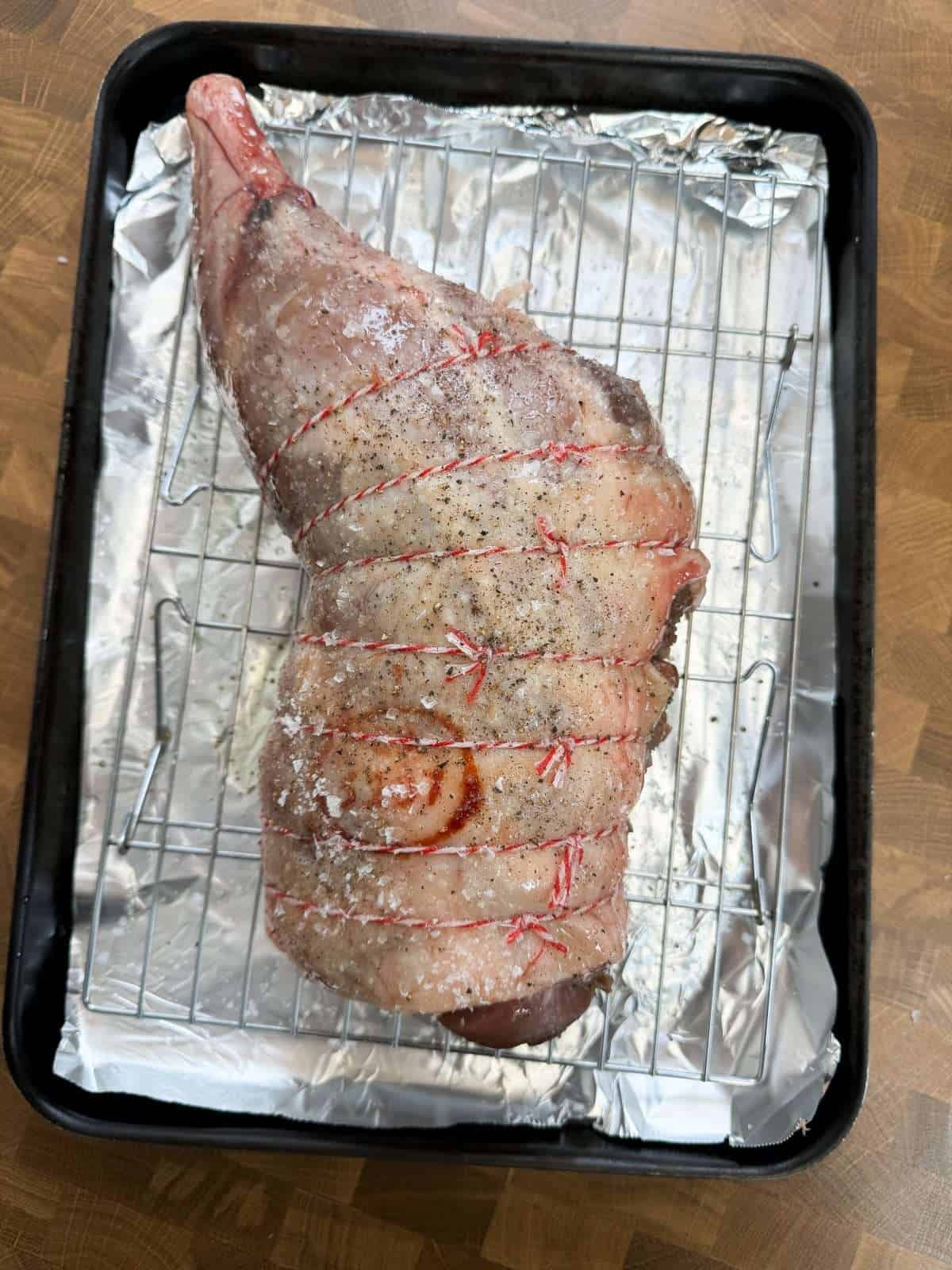
Resting
Once our lamb is cooked, we need to let it rest for an hour or so, covered loosely in foil. Whilst the meat’s resting, the internal temperature will rise by a few degrees, making the lamb perfectly pink. Resting also relaxes the meat & redistributes the juices, making the lamb juicier & more tender.
Searing
As we’ve roasted our lamb at a low temperature, the outside will still be pale so will need to be seared to crisp up & colour the skin. This is why this method cooking is called a reverse sear, as we sear the meat once it is cooked, unlike regular roasting where you sear the meat first.
To sear our leg of lamb, we turn our oven up to its’ highest setting (this will be around 260°c/500°f) then cook the lamb (without the foil!) for 6-8 minutes until the skin is nice & crisp and the outside of the meat is well seared. We don’t want to overcook the lamb though, so make sure not to leave it in the oven for too long!
Once seared, there’s no need to rest the lamb again, we just need to remove any string then cut the meat into slices.
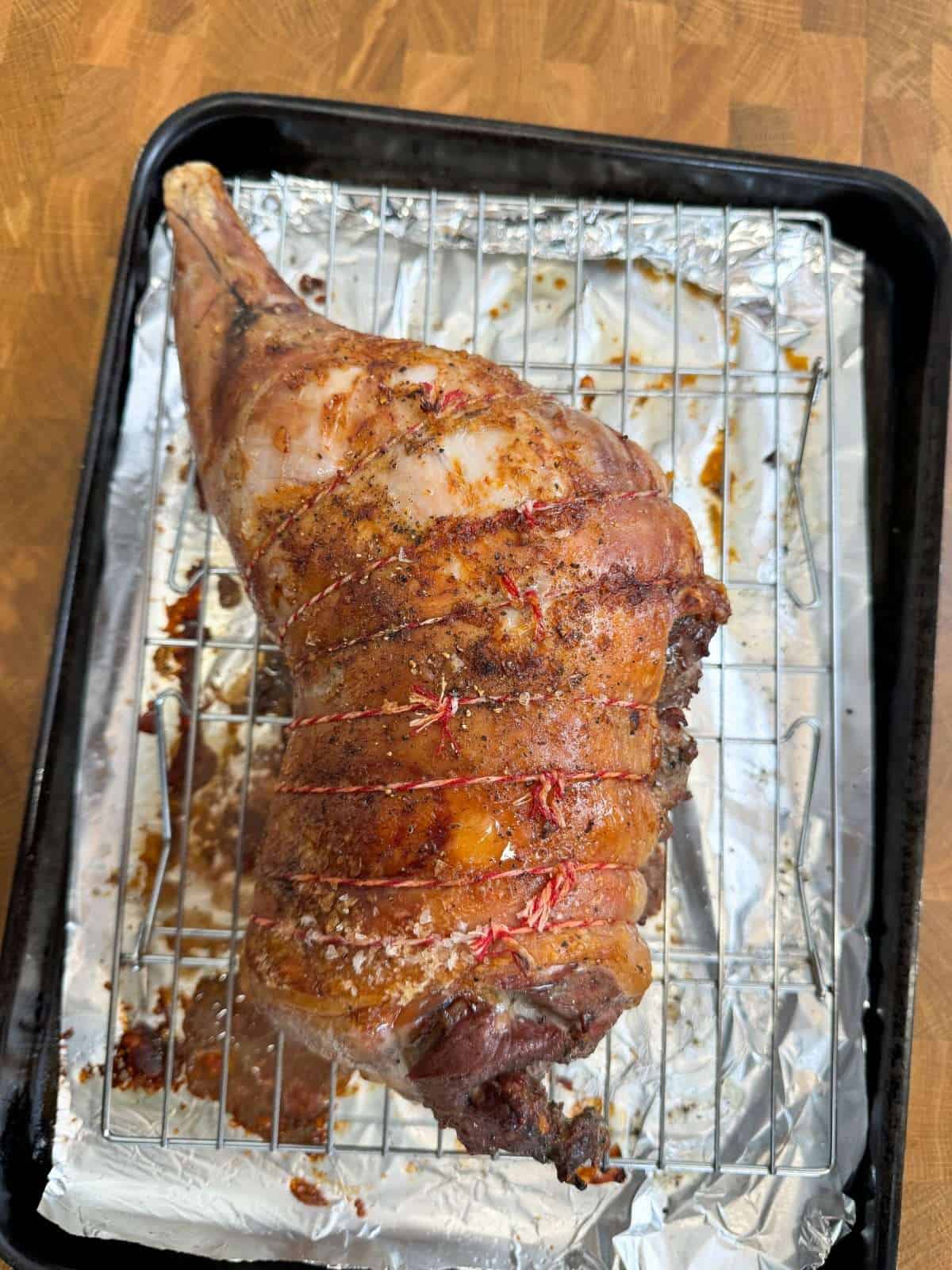
Tips & Tricks For Perfect Roast Lamb
- Get your lamb from your local butcher. It’s a bit pricier but the quality is so much better!
- Remove the bone from the leg meat and trim off any connective tissue & cartilage. This makes our roast lamb easier to carve & extra tender.
- For extra flavour, marinade your lamb with fresh garlic & rosemary and let it sit in your fridge overnight (or at least a couple of hours).
- Avoid overcooking your lamb by using a digital food probe to check the internal temperature of the meat.
- Let your roast lamb rest for an hour after cooking (before searing) then sear at a high temperature, to crisp up the skin.
Frequently Asked Questions
Yes, a leg of lamb can be reverse seared whether it has a bone in or not! The cooking method is exactly the same for both a bone in & boneless leg of lamb.
Leftover roast lamb needs to be stored in the fridge & it will keep for up to 3 days. You can serve leftover roast lamb cold, in salads & sandwiches or reheat it & use it for a quick & easy dinner.
Leftover roast lamb is best reheated in gravy! To do this, cut your lamb into slices & place into a heatproof dish with plenty of gravy. Cover the dish with foil then bake in a 180°c/356°f oven until hot. Keep in mind that the lamb won’t be as pink once it has been reheated.
The best way to check whether your roasted leg of lamb is cooked, is to use a digital food probe to check the internal temperature in the centre of the joint. For roasted leg of lamb cooked medium, we take the lamb out of the oven when it hits an internal temperature of 55°c/131°f. The temperature will rise to 60°c/140°f as the meat rests.
For the cleanest slices, it’s best to use a long (8″-12″), straight edged carving or chef’s knife to slice your roast lamb. Make sure it’s super sharp! You’ll also need a pair of scissors to remove any string/twine, that was used to tie the joint up.
Cooking Slow Roasted Lamb In An Aga
With all of my recipes, I include cooking instructions for conventional ovens, fan ovens & also Agas. Here’s how to cook this recipe in an Aga…
Slow roast the lamb in the simmering oven, on the second from bottom set of runners. Sear the lamb in the roasting oven. Place your roasting tin as high in the roasting oven as you can, without letting the meat touching the top.
Equipment Used
Please note that these are affiliate links & I may make a small commission if you make a purchase using these links, at no extra cost to you. For more information, click here.
What To Serve With Slow Roasted Leg Of Lamb
- Goose Fat Yorkshire Puddings
- Black Garlic Roast Potatoes
- 3 Cheese Cauliflower Cheese
- Honey Roasted Carrots & Parsnips
- Braised Red Cabbage
- Caramelised Onion & Sage Stuffing
- Red Wine Gravy
Watch How To Make This Recipe

If you have enjoyed this recipe for slow roasted leg of lamb it would mean a lot if you could leave a review & rating. And if you’d like to stay up to date with future recipes, follow us on Instagram & TikTok!
Slow Roasted Leg Of Lamb (Reverse Seared)
Equipment
- Small Mixing Bowl
- Boning Knife
- Butcher's Twine
- Roasting Tin With Rack
- Digital Food Probe
Ingredients
- 2½ – 3 kg Bone In Leg Of Lamb (See Notes)
Garlic & Rosemary Marinade
- 2 tsp Finely Chopped Rosemary
- 4 Garlic Cloves (Grated)
- Zest Of 1 Lemon
- 1 tbsp Olive Oil (Plus Extra For Cooking)
Instructions
Garlic & Rosemary Marinade
- Add the rosemary, garlic, oil & lemon zest into a small mixing bowl, season well with sea salt & freshly cracked black pepper then stir to combine. Set this aside for now.
Deboning & Rolling The Lamb
- Pat the meat dry with kitchen paper then set the leg of lamb onto a large cutting board so that it's facing skin/fat side down & the shank is facing away from you. Use your fingers to feel where the bone is running through the bottom part of the leg.
- Using a sharp boning knife, cut straight through the meat in the bottom part of the leg until you reach the bone. Make sure not to cut into the shank though, as we're leaving the top part of the bone in the leg.There's a visual guide to removing the bone in the post above! The bone runs in a pretty straight line but don't worry if misjudge your cut slightly as we're going to be butterflying the meat anyway!
- Use the tip of your knife to carefully cut the meat away from the top & sides of the bone, cutting away small sections at a time. Work your way up the bone towards the knee joint & shank.
- Once you've cut enough meat away from around the bone, you'll be able to get the tip of your knife underneath, to cut the meat away from the bottom part of the bone as well. Keep working your way up & around the bone until you reach the top of the bone, where it connects at the knee joint.At this point, the bone will be free from the leg meat but still attached at the joint.
- Bend the leg bone up towards the shank, to open up the joint then cut between the 2 bones (through the joint) & around the top of the leg bone, to release it.You can use the leg bone for stocks & gravy!
- Trim any bits of bone, cartilage or big chunks of fat from inside the leg then butterfly the meat on either side of where the bone was, making sure not to cut all the way through the meat.
- Next, lightly score the meat inside the leg in a criss cross pattern then spoon over the marinade & massage into the meat.
- Fold the meat back together, to its' original position then flip the leg over so that it's facing skin side up. Tie the boneless portion of the leg up with butcher's twine, to secure, leaving a couple of centimetres between each piece then let the lamb sit uncovered in the fridge overnight.
Slow Roasting
- Take your lamb out of the fridge, place onto a rack set inside a roasting tin then let the meat sit at room temperature for 1 hour.The lamb should be sitting fat/skin side up.
- In the meantime, preheat an oven to 120°c/100°c fan (248°f/212°f).
- Next, brush the outside of the lamb with a light layer of olive oil then season generously with sea salt & freshly cracked black pepper.
- Place the lamb into the preheated oven then cook until the internal temperature reaches 55°c/131°f. This will roughly take between 2-3 hours.Check the lamb regularly after 2 hours. Make sure to probe the meat in the centre of the joint.
- Once cooked, take the lamb out of the oven, cover loosely with foil then leave to rest for at least 30 minutes or up to 1 hour.
- Whilst your lamb is resting, turn your oven up as high as it will go. In most oven this will be around 260°c/500°f.
- Once your lamb has rested, remove the foil then cook in the preheated oven for 6-8 minutes, until well seared. The skin should be golden brown & crisp.
- Transfer your lamb to a chopping board, remove any string then cut into slices.

